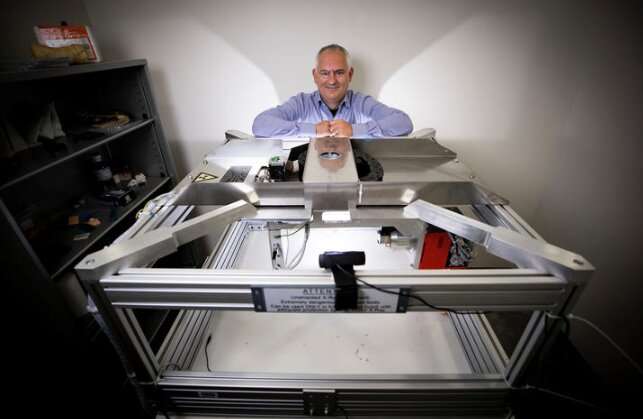Global competition launched to decipher the Herculaneum scroll


Credit: University of Kentucky
They are among the most iconic and inaccessible damaged manuscripts in the world.
Burned and buried during the eruption of Mount Vesuvius in AD 79, the Herculaneum scrolls provide a unique window into the ancient world.
Unfortunately, they are too fragile to spread out.
But now you can help revive the ancient library from the ashes of the volcano. Brent Seales, professor of computer science at the University of Kentucky, is leading a GLOBAL competition to read charred scrolls after demonstrating that an artificial intelligence (AI) program can successfully extract letters and symbols from X-ray images of unrolled papyrus (EduceLab-roll).
“Faculty researchers and students are very good at making breakthroughs, and we did,” Seales said. We demonstrated that ink detection and virtual opening work. moving on Herculaneum scrolls”. “What a competition can do now is amplify and accelerate those breakthroughs—refine them in ways that took us years to achieve.”
For more than two decades, Seales and his dedicated team—of staff and students who research with the Digital Recovery Initiative, part of EduceLab—have worked diligently to create high technologyNon-invasive tool to rescue hidden texts and restore them to humanity.
As part of the Vesuvius Challenge, Seales’ team will release its software and thousands of 3D X-ray images of two scrolls and three pieces of papyrus.
It is hoped that the $500,000 prize will incentivize global researchers and scholars to build on AI technology and accelerate the decoding of the only intact library that exists since ancient times.
Participating teams will compete for the grand prize of $150,000—given the first person to read four passages of text from the inner layers of the scroll by the end of 2023. The progressive prize includes $50,000. for the accurate detection of ink on papyrus from 3D X-ray scans.
“Another exciting aspect of the competition is the opportunity it presents to our students,” explains Seales. “To put them on the global stage in this way—work behind the scenes with Silicon Valley executives and experts in the field, enhancing their training and capabilities.”
Two unopened scrolls, belonging to the Institut de France in Paris, were among hundreds of scrolls unearthed in the 1750s when excavations at the buried mansion revealed a lavish library of texts Epicurus’ philosophical text. They are believed to have belonged to a Roman statesman—possibly Lucius Calpurnius Piso Caesoninus, Julius Caesar’s father-in-law.
In 2016, Seales’ developed Volume Cartographer, a revolutionary computer program for locating and mapping 2D surfaces within a 3D object. The software pipeline is used with micro-CT to produce extremely high-resolution images—allowing the ability to read a document without having to open it. The charred scroll from En Gedi is First complete text disclosed using the software.
Because it works with X-rays, Volume Cartographer software relies on the presence of metal in the ink to help distinguish writing from the surface it rests on. But Herculaneum ink is different from the ink used to write medieval documents and ancient Hebrew. It is made of carbon, which is invisible to the human eye in micro-CT images.
To solve this problem, Seales and team developed a neural network “learn” how patterns in the data look in the presence of ink, as opposed to how patterns appear without ink. A machine learning algorithm is trained to detect and recognize unique data signatures. Breakthrough work introduced for the first time in a PLEASE ONE article.
Seales explains: “No one can blame researchers of the past, because no other time in history has given us such technological advancements and the spirit of collaboration that exists now. hour”. “Plus, there’s a renewed interest in the classics. We recognize that people may not always appreciate the great works, literature, and philosophy of the past. All these problems make now the perfect time to open up this challenge to the world.”
The team remains confident they are about to be able to fully read the ink, and that collaboration from fellow researchers could eventually lead to a more complete understanding of the scrolls.
“We believe others will benefit and extend our findings in very positive and meaningful ways that will inspire rapid development,” said Seales.
He is considered a leading expert in the digital recovery of cultural artifacts. To this day, his quest to discover ancient Western wisdom continues to evolve.
And though, at times, progress is slow and breakthroughs seem distant—Seales believes the Herculaneum papyrus will succumb to modern technology and, more importantly, his team’s resolve by the end of the year. now.
“We plan to continue to show the world what can be done, right here in the UK,” he said. “Recovering the damage incurred over a 2,000-year period is no small challenge. But that’s what we do in Kentucky—conquer the seemingly impossible.”
Provided by
University of Kentucky
quote: Launch of the global competition to decipher the Herculaneum scrolls (2023, March 21) accessed March 22, 2023 from https://techxplore.com/news/2023-03-global-competition-decipher -herculaneum-scrolls.html
This document is the subject for the collection of authors. Other than any fair dealing for private learning or research purposes, no part may be reproduced without written permission. The content provided is for informational purposes only.




